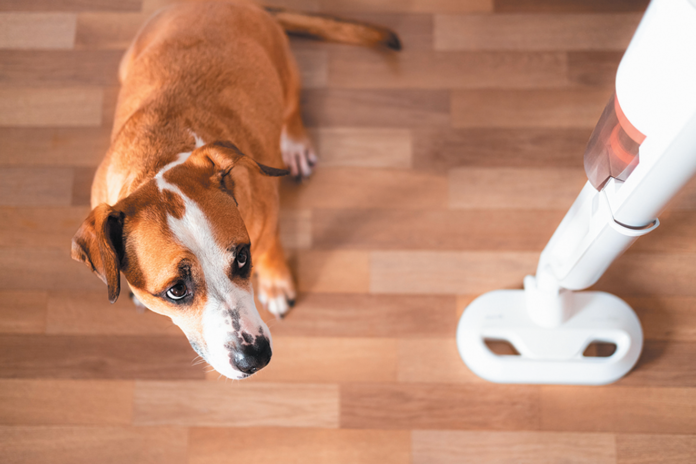We have good news for you. If your dog is afraid of something — the vacuum cleaner, slippery floors, car rides — you do not have to go against your instinct to protect your pet from whatever terrorizes him. In fact, forcing him to keep coming into contact with something that frightens him and perhaps makes him shiver or whine with dismay is called flooding, and besides being cruel and inhumane, it doesn’t work. Imagine if you were intensely afraid of spiders and someone kept insisting you sit in a bathtub crawling with them to get over it.
People may employ a flooding tactic because they have been taught it’s the right thing to do: “Oh, just keep exposing him to whatever he’s afraid of. He’ll get over it.”
No, he won’t. It might seem as if he has gotten over it after a while because his fight-or-flight response will give way to putting up with whatever petrifies him. That is, exhaustion will stop him from visibly reacting. But he’ll still be miserable and will suffer more trauma every time he is made to confront the thing that scares him.
We’ve even heard of a trainer who “helped” a dog afraid of the noise made by a boiler by tying the dog to the boiler until he finally quieted down. The trainer mistakenly believed he had accustomed the animal to the machinery. Similarly, if a dog is scared of walking on slippery surfaces, some trainers will drag him onto one and wait for the signs of panic to subside, erroneously thinking that means the panic itself subsided.
Systematic desensitization
Much more humane than flooding, and much more effective, is a technique called systematic desensitization. It takes more thought, planning, and patience than flooding, but the upside is that it doesn’t involve making your dog miserable. Better still, it works. Here’s an example.
Let’s say your dog is afraid of car rides. Start by feeding him something delectable next to the car without making any move to open the doors. That way, he will begin to associate the “steel dragon” with something pleasant. After a few times, when it’s clear that you don’t have to coax your pet out to the car, feed him on the floor in the back. Another day, just play with your dog in the back seat. Try that for a couple more days, and then try it with the engine on. If he gets scared, go back to feeding him and playing with him in the car without starting it. A couple of days later, try starting the car again. Your dog’s reactions will dictate how fast or slowly the process should go.
Once you see that your dog is okay with the sound, let your car roll backwards for a few feet in the driveway, ever so slowly. This is a big step. Not only will your dog be adjusting to the movement, he will also be adjusting to your moving from the back to the front seat.
Finally, after perhaps a couple of weeks or more, your dog will be ready to let you chauffeur him around the block. Provide lots of praise and cooing the entire time. Do not provide sympathy, as in, “Oh, you poor thing.” That will only reinforce the notion that he is in fact going through something awful that requires sympathy.
Not showing sympathy doesn’t mean not being nice; it just means acting calmly rather than letting him know through your tone that you feel bad for him — which of course you do, but exhibiting that won’t help him. Better to keep the talk encouraging and admiring. “Oh, what a good boy you are! We’ll be home very soon. Then you’ll have a treat.” (Chances are he knows the words “home” and “treat” even if you haven’t taught them to him.)
Before long your pet will be able to tolerate your driving. It’s then time to drive him somewhere he actually loves to go — the park, a friend of yours who showers him with attention. Over time, his phobia about car rides will have effectively loosened its grip.
All fears your dog has require a patient, structured approach. He can’t just “get over it.” If he could, he would.
Not showing sympathy doesn’t mean not being nice; it just means acting calmly rather than letting your dog know through your tone that you feel bad for him — which of course you do, but exhibiting that won’t help him. Better to keep the talk encouraging.





